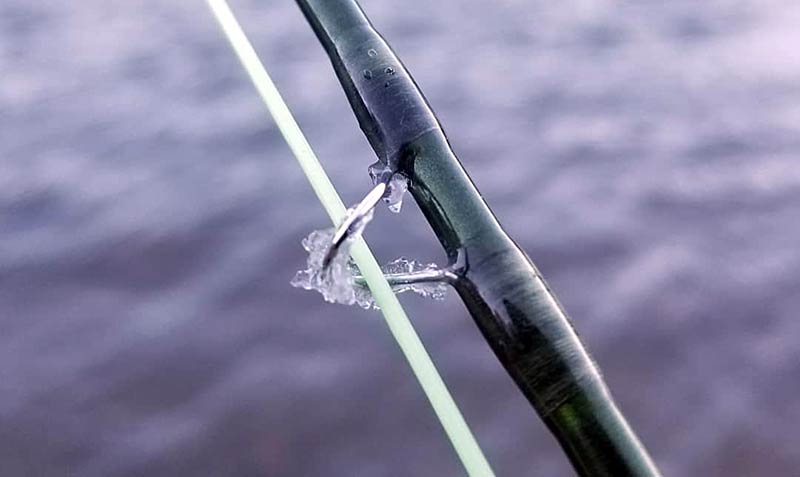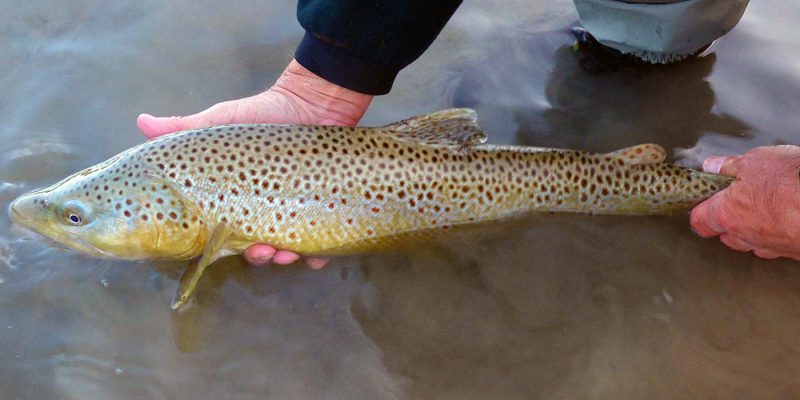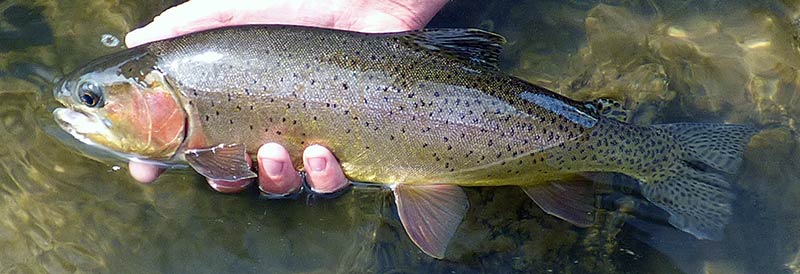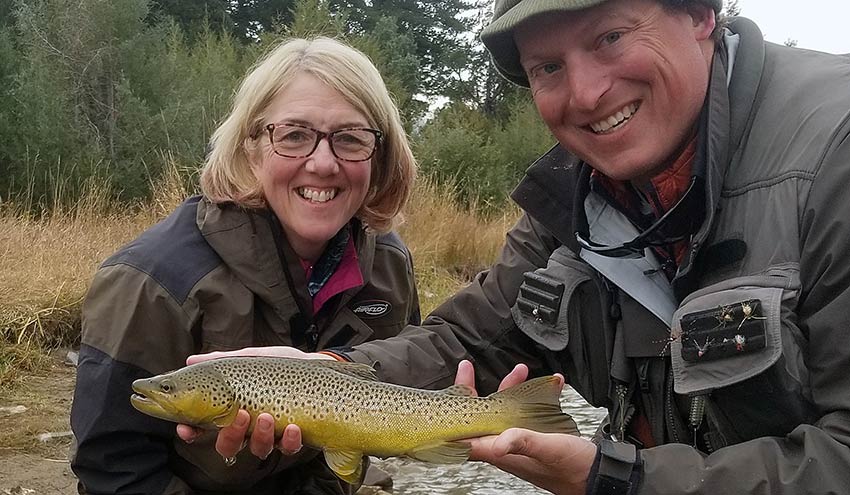Early Fall Yellowstone Fishing Trips
Posted on February 1st, 2021 in Uncategorized
Introduction to Early Fall Yellowstone Fishing Trips
Early autumn in Yellowstone, generally meaning the month of September after nights start getting cold but the first heavy low-elevation snows have not fallen, offers the widest range of fishable waters of any season. Except for most small streams, which get too low and cold, virtually all water in Yellowstone Park can fish well in early fall.
For those who like match-the-hatch mayfly fishing, this is an ideal period, since mayfly hatches abound on all larger streams. It’s also a good chance for those who are willing to get out first thing in the morning or during the ugliest weather to get some of the biggest brown trout of the year.
The downsides are continued crowds near the road and inconsistent conditions. While overall crowds do decline, especially after September 15, these crowds slant older and less-fit, which means that the roadside easy-access streams can be more crowded now than earlier in the season, especially when the weather is nice.
Speaking of the weather, it might be beautiful and sunny or spitting bitter cold rain or snow. These varying weather (and water) conditions also mean that on our early fall Yellowstone fishing trips we have to play where and how we fish by ear, based on what fishes well given the day-to-day or even hour-to-hour conditions.

When you start seeing ice in your guides at dawn, it’s time for early fall fishing in Yellowstone.
Early Fall Yellowstone Fishing Trips: Quick Facts
- Best Waters: Rivers are better than small streams and lakes in early fall. Otherwise, the best waters depend on angler goals. The Yellowstone River remains a great choice regardless of weather for anglers eager to catch cutthroat trout in remote settings, while the Lamar and Slough Creek offer technical dry fly fishing as long as the weather isn’t too warm or too cold. When the weather’s ugly, the Firehole, Gibbon, and upper Madison turn on in a big way, and fall-run brown trout numbers steadily improve on all rivers that host them.
- Three Top Reasons to Come in Early Fall: 1.) Excellent mayfly hatches occur on most rivers, even rough-and-tumble water where hatches are otherwise unimportant. 2.) A huge variety of rivers are available; September is typically the month when all rivers in Yellowstone Park produce, though not all on the same days. 3.) Fall-run brown trout fishing gets better and better as the month progresses (and the worse the weather gets).
- Three Top Reasons to Avoid Early Fall: 1.) Gentle rivers and streams within 1.5mi of the road are unbearably crowded, especially before the typical mid-September cold snap. 2.) How well specific rivers and techniques produce depends hugely on weather. This is a poor time to come if you’re set on fishing one particular river or using one particular technique. 3.) The weather can be bright and beautiful, cool, drizzly, and unsettled (which is best for fishing), or miserable enough to make fishing impossible due to cold weather or muddy water. This is not autumn as it’s thought of in many parts of the country.
- Perfect Clients: Early fall is a great choice for experienced and adaptable anglers willing to fish the rivers likely to fish well and use the techniques likely to produce given weather and water conditions.
- What Early Fall Does Best: Early fall offers exceptional variety in river fishing, from small fish sipping tiny BWO mayflies on the Firehole on up to big cutthroats eating streamers on the Yellowstone.
September Trips: The Details
Sometime between August 20 and September 10, the nights start getting frosty while the days remain warm. This begins to change the options and techniques on walk-wade guided trips in Yellowstone. The small streams start to falter, as do the heavily-pressured meadow waters next to the road like Soda Butte Creek where we seldom run guided trips due to the crowds.
The bigger and rougher waters remain good, though early morning is seldom worthwhile except when anglers are hunting a couple big fish on nymphs and streamers rather than a bunch of little ones on dries. Thankfully, big fish opportunities increase at this time, as large numbers of brown trout begin moving towards their October-November spawning areas, prompted by cooling water. Dry fly fishing switches from better in the mornings and early afternoons to typically better in the afternoons, and terrestrial insects and lingering summer mayflies are joined and soon replaced by heavier hatches of autumn insects.

Brown trout are key quarry on early morning fall Yellowstone fishing trips
This is an excellent period for walk-wade trips for clients who want to use a variety of tactics and even see a variety of waters in one day. Probably our most popular fall walk-wade excursion consists of nymph fishing on “River X” for a few larger brown trout starting at dawn, followed by streamer and dry fly fishing for numbers of cutthroat on the Yellowstone River in its canyons from late morning through midafternoon. Similar fishing is also possible on our combo trips. If you’d rather hop in the boat at midday for dry-fly eaters instead of navigating the Yellowstone’s rugged canyon walls on foot.
For anglers who’d rather hike a bit more and fish one water, the Yellowstone remains good, as do canyon stretches of the Lamar. Slough Creek and bouldery portions of the lower Gardner are good secondary options, though Slough in the fall is strictly for expert anglers eager to sight-fish for big, challenging trout. As early autumn progresses, the Gibbon and Firehole rejoin the party, though we seldom guide on them when rain and early snow (yes, it can happen in September) muddy the water closer to home.

At midday, early fall offers excellent dry fly fishing for cutthroat trout in fantastic condition.
Early fall typically offers very good fishing on walk-wade trips, especially for anglers with a bit of know-how who like nymph fishing and matching hatches. That said, it’s also an inconsistent time of year, primarily due to weather and water conditions. When it’s abnormally hot and bright, the big browns sulk and the mayfly hatches might not occur. Cold weather is better, but if this cold is accompanied by too much rain and snow, most of the good waters (Yellowstone, Gardner, and “River X”) can get muddy for a day or two.
Because of the lack of consistency, we encourage anglers considering early fall Yellowstone fishing trips to stay flexible. Walk when and where the walking is good and use the techniques the trout demand. If it looks like another one of our guided trips will be more productive, don’t hesitate to switch.
Full-day or half-day hike & wade trips make sense in this timeframe. Unless we’re looking for a few big ones early, there’s often no reason to start full-day trips before 9:00, especially later in September.
Unless the weather stinks, any trip in which we are trying to catch larger brown trout will need to be on the water and ready to fish at dawn, typically a bit before 7:00AM. This might mean a meeting time as early as 4:30AM depending on where you’re staying and where we’re meeting.
Half-days in which we’re not chasing browns can meet at a far more civilized time, around 11:00.
Early autumn is not a great time for beginners to take walk trips unless they’re prepared to only get a few bites and mostly want to focus on learning rather than catching a lot of fish. Beginners typically catch FAR more fish on our float trips by this late in the season.

With all these brown trout pictures, have you noticed how we tend to crop things really close so it’s hard to see identifiable landmarks in the background? Do you think that could be to keep our competition from knowing exactly where we’re fishing? Maybe…